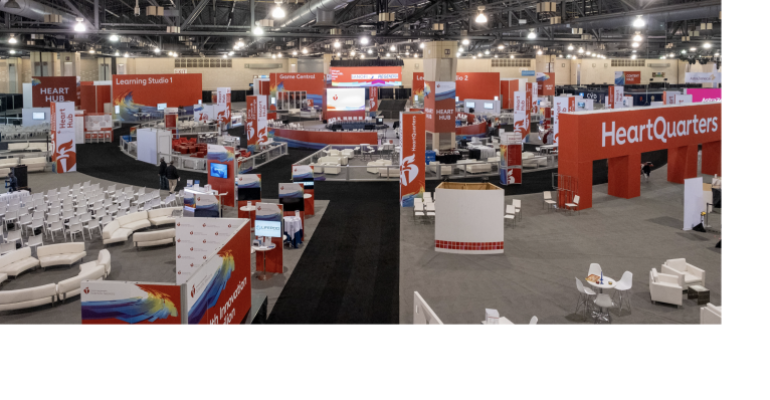As any meeting planner will tell you, 101,000 square feet is a heck of a lot of space to devote to a non-exhibit element at an annual meeting. But in November 2019, the American Heart Association’s annual Scientific Sessions in Philadelphia featured an area that size called the HEART Hub. The result of a two-year collaboration between AHA and Freeman, HEART Hub’s 17 attendee-activation elements delivered so well on AHA’s goals that they’ll use this event element again at the 2020 Scientific Sessions in Dallas.
Hitting Critical Objectives
Danielle Urbina, vice president of corporate and scientific meetings and events for AHA, presented the HEART Hub’s success story at the Professional Convention Management Association’s Convening Leaders conference in January. There, she said that AHA faced this challenge: “Attendees come to the Scientific Sessions primarily to earn CME credits, and the show floor has to compete for their time.” As a result, “we wanted to turn part of the exhibition space into an engagement area that would move attendees through our Science & Technology Hall,” noted Urbina (pictured here).
Jack Boyd, client solutions senior vice president for Freeman, which has a strong presence across the cardiovascular events market, adds that “our strategy team worked with AHA to analyze their attendee and exhibitor data and volunteer feedback. Based on that, the key initiatives we all agreed to move on were attendees’ desire for a centralized learning area; access to thought leaders, innovators, and experts; networking focused on research and programming; more digital engagement components; and ease of navigation and wayfinding throughout the event. And from a wider perspective, the goal was to strengthen the brand perception of AHA.” The HEART Hub concept addressed all of these.
For the three-day, 14,000-attendee event that took place across halls A through E of the Pennsylvania Convention Center, the HEART Hub was placed in hall C, between the Main Event (general session) space and the Science & Technology Hall (exhibit pavilions). To enhance the HEART Hub’s influence on the flow of attendee traffic across the entire show, AHA employed a spoke-and-wheel design that allowed aisles from each adjoining hall to flow to the center of the HEART Hub. “It was designed to create a deliberate attendee journey, where people could engage with different types of event participants along the way and then network with fellow attendees in various conversation spaces,” notes Scott Collinsworth, client solutions director, audiovisual, for Freeman.
Laying Out the HEART Hub
In this 101,000-square-foot circular pavilion, one side is devoted to small-group conversation areas featuring thought leaders plus larger learning stations with a variety of set-ups and content that otherwise would be delivered in breakout rooms. AHA’s HeartQuarters is also located there, to expose attendees to all of the association’s offerings.
On the other side of the HEART Hub are two “learning labs” that feature a mix of CE-eligible and sponsored educational sessions. These 200-person theaters are the lone areas of HEART Hub to have walls, so that only attendees can enter and listen to the presentations, not competitors of the presenting firms.
To keep the sound from leaking outside the theaters, Freeman AV had to add soundproofing to the 16-foot-high walls as well as position speakers so that sound only escaped towards the ceiling. Actually, Collinsworth had his work cut out for him to provide quality sound in every area of the HEART Hub. “With no walls anywhere else, it took a lot of time and effort to discover the best audio-delivery systems and set-ups to keep sounds from bleeding from one area to another.
 Between the two learning labs is the HEART Hub’s largest theater, which also provides the most energy to the area. It’s dubbed Game Show Central, and it features teams of attendees competing against each other to correctly answer questions developed by AHA staff. Partially surrounded by plexiglass to catch the attention of passersby, “Game Show Central works because physicians and medical students are naturally competitive,” says AHA’s Urbina. “It’s a crowd favorite,” adds Boyd.
Between the two learning labs is the HEART Hub’s largest theater, which also provides the most energy to the area. It’s dubbed Game Show Central, and it features teams of attendees competing against each other to correctly answer questions developed by AHA staff. Partially surrounded by plexiglass to catch the attention of passersby, “Game Show Central works because physicians and medical students are naturally competitive,” says AHA’s Urbina. “It’s a crowd favorite,” adds Boyd.
To draw the attention of younger attendees, AHA sets up digital activations in a health-technology area within the HEART Hub, while a nearby “content maze” serves as another interactive learning opportunity. The programming within those elements is created by AHA staff and volunteers, not by exhibitors or sponsors.
With the debut of the HEART Hub behind them, AHA and Freeman are now deep into strategic planning for the elements that will comprise the HEART Hub at AHA’s 2020 Scientific Sessions in Dallas in November. “The feedback from event participants showed great support for the concept,” says Boyd. “Every association wants to stay relevant in their marketplace; listening to members and exhibitors while looking at best practices and industry trends at shows in your industry and in other industries can bring about ideas like the HEART Hub.”





